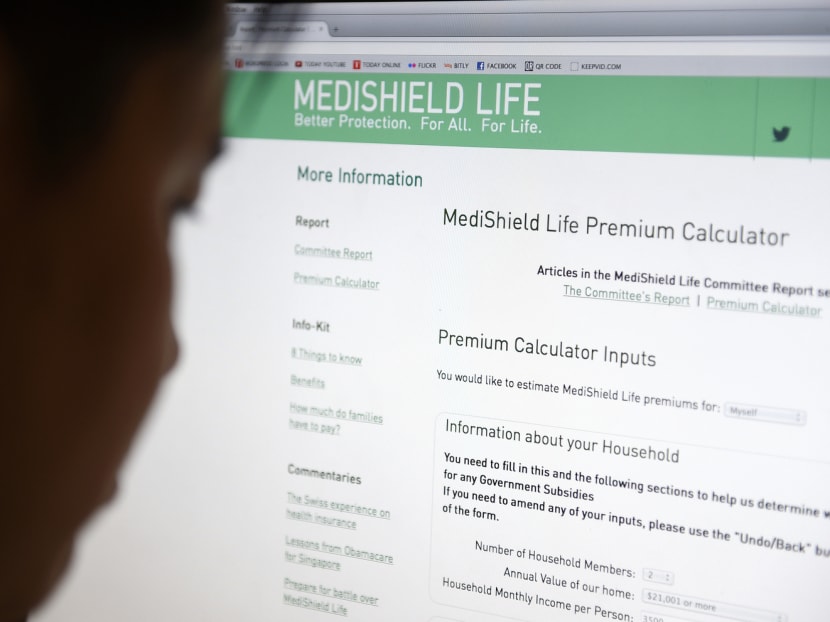Large part of MediShield Life premiums will support future claims, rebates: MOH
SINGAPORE — Premiums collected for MediShield Life are meant to support not only claims made in the same year but also those that recur and stretch into the future, the Ministry of Health (MOH) has said in response to TODAY’s queries on the large quantum of premiums collected vis-a-vis the payouts disbursed in its first 11 months of implementation.
SINGAPORE — Premiums collected for MediShield Life are meant to support not only claims made in the same year but also those that recur and stretch into the future, the Ministry of Health (MOH) has said in response to TODAY’s queries on the large quantum of premiums collected vis-a-vis the payouts disbursed in its first 11 months of implementation.
To distribute premiums more evenly throughout a person’s lifetime, a proportion of an individual’s premium is also set aside for pre-funding of premiums in their senior years, the MOH explained, noting that the pre-funding proportion “can go up to half of the premiums paid during the working ages”.
On Oct 31, the MOH announced that S$1.736 billion was collected in premiums for MediShield Life from November last year to September this year — almost three times higher than the payouts, prompting some to question the disparity.
The Government had previously said that MediShield Life premiums had to be raised to provide enhanced benefits but it has pledged close to S$4 billion over five years in premium subsidies and other forms of support for households, and also raised Medisave contributions by employers.
Experts said that the gap between premiums and payouts could narrow as the share of the elderly in Singapore rises, and that the State could be collecting more in the first few years of a scheme based on fiscal prudence.
Replying to TODAY’s queries, the MOH said the ratio of premiums to claims in a single year does not accurately represent the adequacy of the insurance scheme. “Premiums collected today are meant to support claims made in the same year as well as recurring claims that are expected to stretch into the future,” said a spokesperson.
For instance, renal failure patients claim up to S$1,000 monthly or S$12,000 yearly. The treatment continues for years, and these patients’ claims are provided for from the MediShield Life Fund reserves, she said.
The Fund, which had S$3.4 billion at the end of last year, retains all premiums, including the Government’s premium subsidies that have not been paid out in claims or expenses. It helps to meet the scheme’s liabilities and buffers against scenarios such as a worse-than-expected claims experience, in line with the Monetary Authority of Singapore’s Risk-Based Capital framework, said the MOH spokesperson. Figures for this year are not available yet.
The spokesperson also noted that premium rebates start from the age of 66, instead of 71 under MediShield previously. Rebates for non-Pioneer Generation individuals who entered MediShield Life before the age of 30, for example, will range from S$49 to S$537 a year from the age of 66, depending on the age band.
Asked about how the premiums-versus-payouts ratio compared with those in other countries with basic universal health insurance, the MOH said overseas schemes may not be directly comparable to Singapore’s scheme, as many have been designed on different principles.
Most do not include pre-funding of premiums, and others “may also be more focused on covering immediate claims, which may not be a sustainable system, as healthcare needs grow with ageing populations”, said the spokesperson.
Insurance economist Joelle Fong said the current gap between premiums and payout could simply reflect population demographics, and this could narrow as the population ages.
“MediShield Life guarantees healthcare coverage for life. Accordingly, we need to take a life-course perspective rather than a single-year perspective in analysing the premiums and claims payouts,” said Dr Fong, senior research fellow at the Insurance Risk and Finance Research Centre of Nanyang Business School.
A related and important question is whether MediShield Life is fair in actuarial terms for the average individual, and the answer to this would require sufficient data on claims experience and healthcare utilisation, as well as how healthcare costs are likely to evolve, she said.
Health economist Phua Kai Hong said that although a measure of efficiency in private insurance is to collect the amount in premiums that the insurer is going to pay out (net of profits), social insurance provided by the government is different.
The state tends to collect more in the first few years of a scheme, based on fiscal prudence and an estimation of maximum claims from eligible individuals. The higher premiums-claims ratio of MediShield Life’s first 11 months is probably the Government erring on the side of caution, said Dr Phua of the Lee Kuan Yew School of Public Policy.
Although he is in favour of parking savings for future healthcare spending in Medisave accounts, Dr Phua said doing it via front-loading for MediShield Life might ease the pinch of rising premiums in one’s older years.
Over a longer period, governments should be better able to manage what they collect and what they pay out, within acceptable limits and other measures of efficiency, he said.







